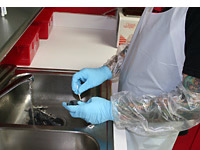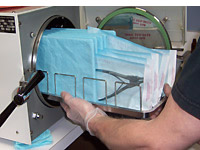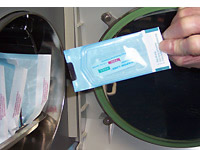Cross-contamination is the act of spreading bacteria and viruses from one surface to another. Since bloodborne viruses can live on objects and surfaces for up to a week, germs could be spread when surfaces are not disinfected the right way or if equipment is not cleaned and sterilized between clients.
Some examples of cross-contamination are:
A piercer places his tools on a counter that has not been disinfected and then uses the tools for a piercing procedure without sterilizing them.
A tattooist, while working on a client, answers the phone without
removing her gloves. By not removing her gloves, the artist may spread
bacteria and viruses from the gloves onto the phone. Other people using
the phone could then be exposed to a disease.
Here is some additional information for preventative practices that may reduce cross-contamination in the body art industry:
-
Gloves should be changed when it is necessary
Gloves must be removed and thrown away whenever a tattooist or piercer leaves his or her work area.1
Gloves should be changed if they tear.2
Disposable gloves must not be washed or reused.1
- Hands should be washed often

Hand washing can get rid of most the disease-causing organisms on a person's hands.3
When wearing gloves, heat and moisture build up.
This creates the right conditions to allow bacteria to reproduce. To lessen the spread of viruses and bacteria, tattooists and piercers should wash their hands before and after wearing gloves.2,3
Gloves are not a substitute for hand washing.
-
Surfaces should be disinfected often
Body artists should disinfect surfaces, such as the client's chair and counter space, between procedures.3The Environmental Protection Agency (EPA) has a list of registered disinfectants that are made to kill certain bacteria and viruses. EPA-registered tuberculocidal disinfectants are best for cleaning surfaces contaminated with blood.4 The germ that causes tuberculosis is one of the most difficult to kill. Any disinfectant that claims to be able to eliminate the tuberculosis germ can also kill HIV, hepatitis B and hepatitis C viruses.4
Many disinfectants need to stay on surfaces for a specific amount of time to fully disinfect the surface before being wiped down. The instructions included with the disinfectant should note the amount of time needed to properly disinfect an area.2
-
Reusable tools and equipment should be cleaned before being
sterilized

Cleaning is the first step in removing viruses and bacteria from equipment.3 Reusable tools and equipment should first be washed manually before being sterilized.2,3 Piercers and tattooists should use
a brush or similar tool to clean reusable equipment whenever possible.4Ultrasonic cleaners work well to clean tools in hard-to-reach places and reduce the amount of time contaminated equipment is handled.3 Shop employers
should check with the owner's manual to be sure the
machine is cared for correctly. -
Use disposable "single-use" supplies whenever possible
Disposable supplies, such as pigment caps, razors, rinse cups, and sterilized pre-made needle bars, should be used once and disposed of. By not reusing disposable supplies, the possibility of being exposed to blood while cleaning them is avoided.
-
Sterilization machines must be regularly tested and
serviced


Photos courtesy of Kris Lachance.
Autoclave machines use steam, pressure, and temperature to kill bacteria, fungi, and viruses. Gauge readings and the color change of indicator strips on autoclave packaging are not reliable ways of ensuring an autoclave is sterilizing correctly.
If the machine is not well cared for, it may not reach
the conditions needed to sterilize reusable
equipment well.
Routine spore tests can check if an autoclave is sterilizing correctly.3,5 Employers should contact their local health department to find out how
often spore tests should be done.The employer should also ensure the autoclave is regularly serviced. The owner's manual should provide information about the maintenance schedule.
-
Contents of this web page represent recommendations by NIOSH. They draw upon regulations and other materials from the Occupational Safety and Health Administration (OSHA) in the U.S. Department of Labor, upon guidelines by the U.S. Centers for Disease Control and Prevention (CDC), and from findings and recommendations by NIOSH. Sources for these recommendations are cited in footnotes. In considering these NIOSH recommendations, users should also be aware of applicable state and local laws that may impact their implementation.
1 (29 CFR Part 1910.1030) Bloodborne Pathogen Standards. Washington, DC: U.S. Department of Labor, Occupational Safety and Health Administration.
External Link: http://www.osha.gov/pls/oshaweb/owadisp.show_document?p_table=STANDARDS&p_id=10051
2 CDC (Centers for Disease Control and Prevention) [1989]. Recommendations for prevention of HIV transmission in health-care settings. MMWR 36(SU-02);001.*
3 CDC (Centers for Disease Control and Prevention) [2003]. Guidelines for infection-control in dental health-care settings. MMWR 52(RR17-6); 1-61 *
4 CDC (Centers for Disease Control and Prevention) [2003]. Appendix A: Regulatory framework for disinfectants and sterilants. MMWR 52(RR17-6); 62-64.*
5 OSHA [2001]. Enforcement procedures for occupational exposures to bloodborne pathogens. U.S. Department of Labor, Occupational Safety and Health Administration, CPL 02-02-069 - CPL 2-2.69.
External Link: http://www.osha.gov/pls/oshaweb/owadisp.show_document?p_table=DIRECTIVES&p_id=2570#APPD
* This guidance is written for healthcare workers, but may also be relevant to other work settings where contact with blood is possible.

